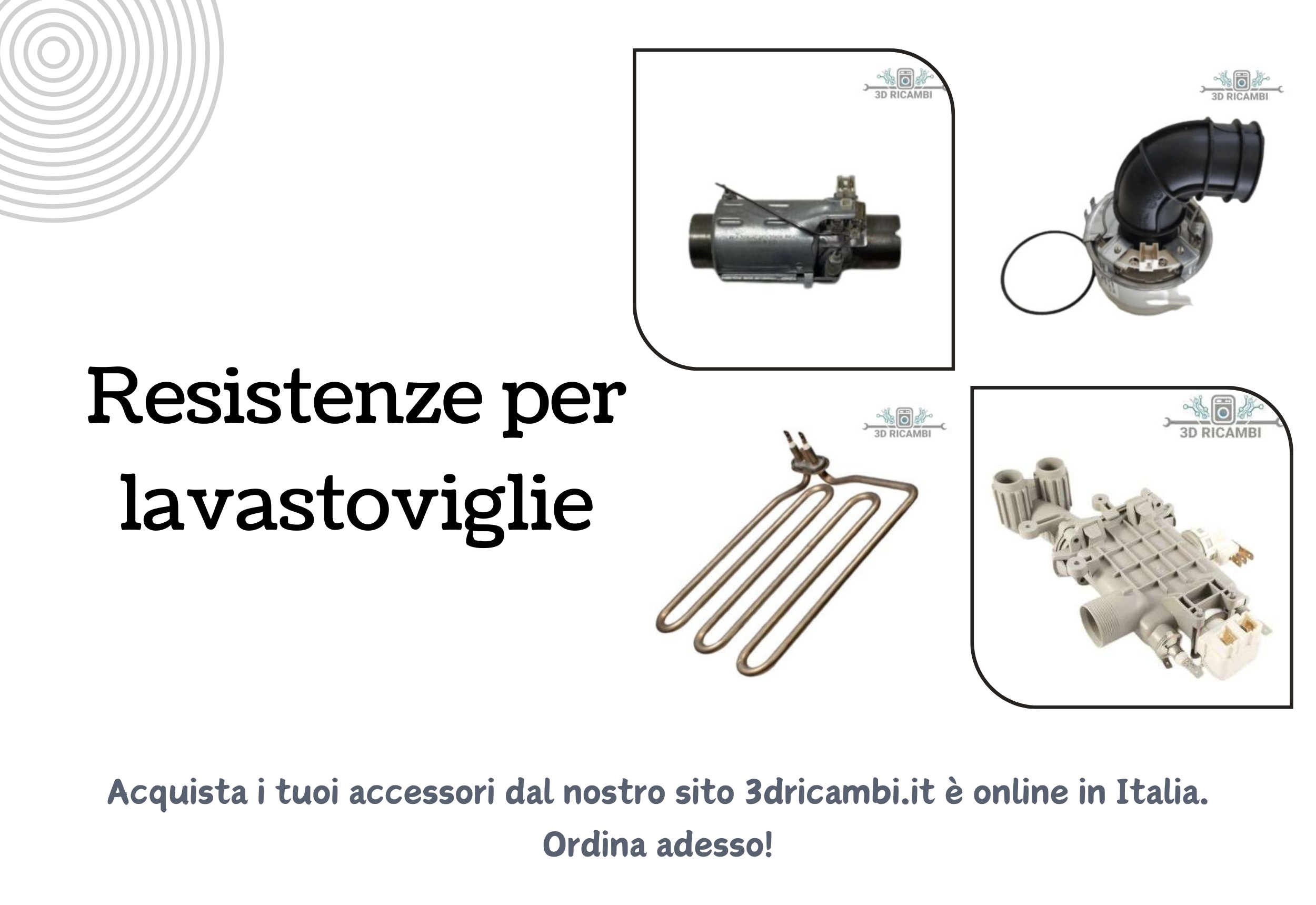Resistenze per Lavastoviglie: Guida Completa

Introduction
Dishwasher resistors are essential components that guarantee the effectiveness of the washing and drying process. These heating elements ensure that the water reaches the ideal temperature to thoroughly clean the dishes and dry them perfectly at the end of the cycle. In this article, we’ll explore the importance of dishwasher resistors, how to keep them in good condition, when to replace them, and how to choose the right ones for your appliance.
What is a Dishwasher Resistor?
Definition and Function
The resistance is a heating element that increases the temperature of the water inside the dishwasher. It is essential for the effective removal of grease and food residues from dishes, as well as ensuring fast and efficient drying.
Why Are Resistances Important?
Deep Cleaning
A functioning resistance guarantees that the water reaches the high temperatures necessary to dissolve fats and thoroughly clean the dishes.
Efficient drying
In addition to cleaning, the resistance ensures that the dishes are dried correctly at the end of the cycle, avoiding water stains and residues.
Energy efficiency
Correct functioning of the heating element helps to improve the energy efficiency of the dishwasher, reducing washing and drying times.
Types of Dishwasher Resistances
Tube Resistance
These resistors consist of a metal tube through which electricity passes, heating it. They are common in many household dishwashers.
Band resistance
Band resistors are flat and thin, ideal for applications where space is limited. They offer fast and even heating.
Cartridge Resistance
These resistors are cylindrical and inserted directly into the water. They are very efficient at transferring heat quickly.
How to Keep Dishwasher Elements in Good Condition
Regular cleaning
Cleaning the inside of your dishwasher regularly helps prevent the build-up of limescale and residue which can damage the element.
Periodic Inspections
Perform periodic inspections of the resistor for signs of wear or damage. Intervening early can prevent bigger problems.
Use of Descalers
Using a specific descaler for dishwashers can help keep the resistance free from limescale deposits, prolonging its useful life.
When to Replace Dishwasher Elements
Malfunction Signs
Se noti che l’acqua non si riscalda correttamente, che le stoviglie non vengono pulite a fondo o che non si asciugano bene, potrebbe essere necessario sostituire la resistenza.
Danni Visibili
Se durante un’ispezione visiva noti crepe, corrosione o altri danni alla resistenza, è il momento di sostituirla.
Cicli di Lavaggio Più Lenti
Se i cicli di lavaggio diventano più lunghi senza una ragione apparente, potrebbe essere dovuto a una resistenza che non funziona correttamente.
Come Sostituire le Resistenze per Lavastoviglie
Passo 1: Acquisto della Nuova Resistenza
Assicurati di acquistare una resistenza compatibile con il modello della tua lavastoviglie. Consulta il manuale dell’utente o contatta il produttore per informazioni specifiche.
Passo 2: Rimozione della Vecchia Resistenza
Scollega la lavastoviglie dalla rete elettrica e dall’alimentazione dell’acqua. Individua la resistenza, solitamente posizionata nella parte inferiore dell’elettrodomestico, e rimuovi i collegamenti elettrici.
Passo 3: Installazione della Nuova Resistenza
Installa la nuova resistenza collegando correttamente i fili e assicurandoti che sia ben fissata. Verifica che non ci siano perdite d’acqua.
Passo 4: Test di Funzionamento
Ricollega la lavastoviglie e esegui un ciclo di prova per assicurarti che la nuova resistenza funzioni correttamente e che l’acqua raggiunga la temperatura ideale.
Consigli per Prolungare la Vita delle Resistenze
Evita Detergenti Aggressivi
L’uso di detergenti aggressivi può danneggiare la resistenza. Opta per detergenti specifici per lavastoviglie che siano delicati sui componenti.
Manutenzione Regolare
Eseguire una manutenzione regolare della lavastoviglie, inclusa la pulizia e l’ispezione della resistenza, aiuta a prevenire problemi maggiori e a mantenere l’elettrodomestico in buone condizioni.
Controllo delle Temperature
Evitare di impostare temperature eccessivamente alte che potrebbero stressare e danneggiare la resistenza.
Innovazioni nelle Resistenze per Lavastoviglie
Materiali Avanzati
Le nuove resistenze sono realizzate con materiali più resistenti alla corrosione e agli agenti chimici, garantendo una maggiore durata e affidabilità.
Efficienza Energetica
Le resistenze moderne sono progettate per essere più efficienti dal punto di vista energetico, contribuendo a ridurre il consumo di elettricità della lavastoviglie.
Funzioni di Autodiagnosi
Alcune lavastoviglie avanzate includono funzioni di autodiagnosi che possono rilevare problemi con la resistenza e segnalare la necessità di intervento.
Conclusione
Dishwasher resistors are fundamental components to ensure the correct functioning and longevity of your appliance. Understanding the importance of these devices, knowing how to maintain them and when to replace them, and adopting good maintenance practices can make the difference between a dishwasher that works perfectly and one that requires frequent repairs. Investing time in taking care of the resistance of your dishwasher will allow you to enjoy perfectly clean dishes and prolong the life of your appliance.
FAQs
How often should I inspect the element of my dishwasher?
It is advisable to inspect the resistor at least once a year to prevent major problems.
How can I tell if my dishwasher element is damaged?
Signs of a damaged element include water that doesn’t heat up properly, longer wash cycles, and dishes that don’t dry well.
Can I replace the heating element of my dishwasher myself?
Yes, with the right tools and following the manufacturer’s manual instructions, you can replace the resistor yourself. If you feel unsure, it is advisable to contact a professional technician.
What are the advantages of modern resistors compared to traditional ones?
Modern resistors offer greater energy efficiency, are made of more resistant materials and may include self-diagnosis functions.
What should I do if my dishwasher still doesn’t heat the water even though the element is new?
If your dishwasher still doesn’t heat the water, check that the element is installed correctly and that there are no other damaged components. If the problem persists, contact a technician for a detailed inspection.

Leave a Comment